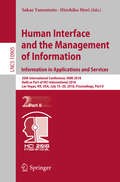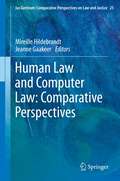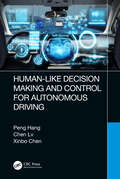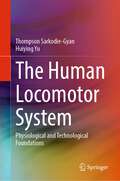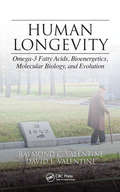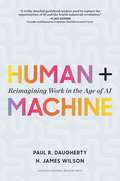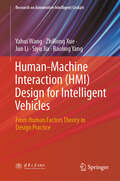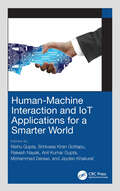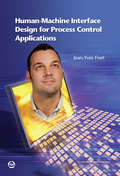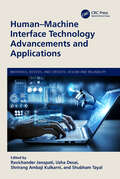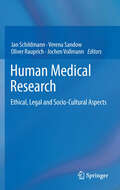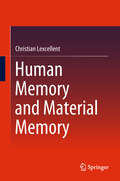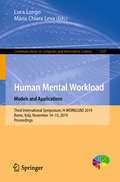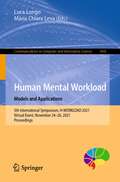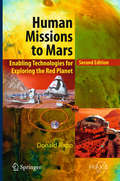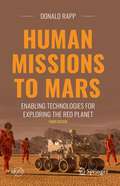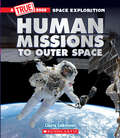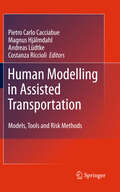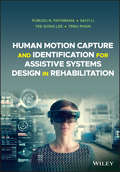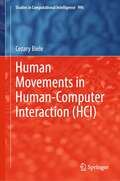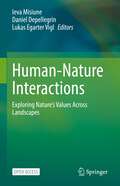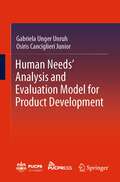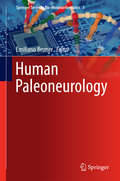- Table View
- List View
Human Interface and the Management of Information. Information in Applications and Services: 20th International Conference, HIMI 2018, Held as Part of HCI International 2018, Las Vegas, NV, USA, July 15-20, 2018, Proceedings, Part II (Lecture Notes in Computer Science #10905)
by Sakae Yamamoto Hirohiko MoriThis two-volume set LNCS 10904 and 10905 constitutes the refereed proceedings of the 20th International Conference on Human Interface and the Management of Information, HIMI 2018, held as part of HCI International 2018 in Las Vegas, NV, USA, in July 2018.The total of 1170 papers and 195 posters included in the 30 HCII 2018 proceedings volumes was carefully reviewed and selected from 4373 submissions.The 53 papers presented in this volume were organized in topical sections named: interacting with information; information and learning; information in aviation and transport; intelligent systems; and sevice management.
Human Law and Computer Law: Comparative Perspectives
by Jeanne Gaakeer Mireille HildebrandtThe focus of this book is on the epistemological and hermeneutic implications of data science and artificial intelligence for democracy and the Rule of Law. How do the normative effects of automated decision systems or the interventions of robotic fellow 'beings' compare to the legal effect of written and unwritten law? To investigate these questions the book brings together two disciplinary perspectives rarely combined within the framework of one volume. One starts from the perspective of 'code and law' and the other develops from the domain of 'law and literature'. Integrating original analyses of relevant novels or films, the authors discuss how computational technologies challenge traditional forms of legal thought and affect the regulation of human behavior. Thus, pertinent questions are raised about the theoretical assumptions underlying both scientific and legal practice.
Human-Like Decision Making and Control for Autonomous Driving
by Peng Hang Chen Lv Xinbo ChenThis book details cutting-edge research into human-like driving technology, utilising game theory to better suit a human and machine hybrid driving environment. Covering feature identification and modelling of human driving behaviours, the book explains how to design an algorithm for decision making and control of autonomous vehicles in complex scenarios. Beginning with a review of current research in the field, the book uses this as a springboard from which to present a new theory of human-like driving framework for autonomous vehicles. Chapters cover system models of decision making and control, driving safety, riding comfort and travel efficiency. Throughout the book, game theory is applied to human-like decision making, enabling the autonomous vehicle and the human driver interaction to be modelled using noncooperative game theory approach. It also uses game theory to model collaborative decision making between connected autonomous vehicles. This framework enables human-like decision making and control of autonomous vehicles, which leads to safer and more efficient driving in complicated traffic scenarios. The book will be of interest to students and professionals alike, in the field of automotive engineering, computer engineering and control engineering.
The Human Locomotor System: Physiological and Technological Foundations
by Thompson Sarkodie-Gyan Huiying YuThe textbook describes the complexity of the human dynamic behavior in space and its ability to produce coordinated, adaptive, dynamically stable movements under steady conditions while negotiating complex terrains and experiencing unexpected perturbations. Applying fundamental theories of biomechanics and physiology, the authors further consider the physical, perceptual, and motor aspects of the locomotor system towards the analysis of how humans can behave adaptively in space by virtue of their intelligent sensory-motor functions and to illuminate our understanding of how this complexity in behavior can provide insight into the neural control of locomotion of the musculoskeletal system. The text provides a foundation for describing the normal and abnormal human locomotor systems. The Human Locomotor System: Physiological and Technological Foundations is intended as a primary text for upper-undergraduate and graduate-level courses in neuroscience, gait analysis, kinesiology, physical therapy, sports science, and biomedical and rehabilitation engineering. It is also a valuable professional reference for scientists and engineers at medical and pharmaceutical companies involved in bioengineering research and development.
Human Longevity: Omega-3 Fatty Acids, Bioenergetics, Molecular Biology, and Evolution
by Raymond C. Valentine David L. ValentineMore than 7 billion people inhabit the earth and all of them are subject to aging. This book is aimed at persons interested in a molecular explanation of how our cells age. Human Longevity: Omega-3 Fatty Acids, Bioenergetics, Molecular Biology, and Evolution is built on the proposition that we age as our mitochondria age. It suggests a revised vers
Human + Machine: Reimagining Work In The Age Of AI
by Paul R. Daugherty H. James WilsonIn Human + Machine, Accenture leaders Paul R. Daugherty and H. James (Jim) Wilson show that the essence of the AI paradigm shift is the transformation of all business processes within an organization--whether related to breakthrough innovation, everyday customer service, or personal productivity habits. As humans and smart machines collaborate ever more closely, work processes become more fluid and adaptive, enabling companies to change them on the fly--or to completely reimagine them. AI is changing all the rules of how companies operate. <p><p> Based on the authors' experience and research with 1,500 organizations, the book reveals how companies are using the new rules of AI to leap ahead on innovation and profitability, as well as what you can do to achieve similar results. It describes six entirely new types of hybrid human + machine roles that every company must develop, and it includes a "leader’s guide" with the five crucial principles required to become an AI-fueled business. <p> Human + Machine provides the missing and much-needed management playbook for success in our new age of AI.
Human-Machine Interaction: From Human Factors Theory to Design Practice (Research on Automotive Intelligent Cockpit)
by Yahui Wang ZhiRong Xue Jun Li Siyu Jia Baoling YangThis book details the knowledge of digital instrumentation human–machine interaction (HMI) design, infotainment system HMI design, multi-mode interaction design, and driving automation HMI design in intelligent vehicles from the perspective of human factors engineering. It explains the design methodology of intelligent vehicle systems, intelligent driving, and multi-mode interaction from multiple perspectives, covering ergonomics theory, industry specifications, design cases, design principles, trends, and challenges in related fields. This book is suitable for automotive user experience (UX) and HMI designers, product managers, etc. It is also used as a textbook or reference book for automotive design, human–computer interaction design, and other related courses in higher education institutions.
Human-Machine Interaction and IoT Applications for a Smarter World
by Nishu GuptaHuman-Machine Interaction and IoT Applications for a Smarter World explores the futuristic trends at the cutting edge of study and research on Human-Machine Interaction (HMI), which is also known as Human-Computer Interface (HCI), and the Internet of Things (IoT) by featuring applications in a proficient, adaptable, and manageable way. It covers the mainstays of the IoT world through a thorough description of the present advancements, systems, and structures. This book: Discusses algorithms and design methodologies for the implementation of HMI based IoT systems. Covers real-time utility of IoT-based devices and systems. Provides human-machine interactive technologies and smart applications using IoT. Covers cyber-physical systems and IoT in HMI, using a blend of theoretical knowledge with a practical approach. It also covers important concepts including smart grid and energy consumption monitoring, smart vehicular and transportation systems, smart home automation, automatic identification systems, supervisory control and data acquisition systems, designing and integrating heterogeneous Human-Machine interactions, virtual and augmented reality, natural language processing, computer vision, and automatic speech recognition. This text will be useful for senior undergraduate, graduate students, and academic researchers in areas including electrical, electronics, and communications engineering, as well as computer science.
Human-Machine Interface Design for Process Control Applications
by Jean-Yves FisetIdeal for users and designers of industrial control and monitoring systems, this book provides an easy-to-use, yet effective, method to configure, design, and validate human-machine interfaces (HMIs). Such systems include distributed control systems (DCSs); supervisory control and data acquisition systems (SCADAs); and stand-alone units. This book also discusses the overall HMI design process; how that process relates to system design; detailed design methods, principles, and rules for individual displays and groups of displays; and integrating both software-based and hardwired HMIs.
Human-Machine Interface Technology Advancements and Applications (Materials, Devices, and Circuits)
by Ravichander Janapati, Usha Desai, Shrirang Ambaji Kulkarni, and Shubham TayalHuman–Machine Interface Technology Advancements and Applications focuses on analysis, design, and evaluation perspectives in HMI technological breakthroughs and applications. It covers a wide range of ideas, methodologies, approaches, and instruments to give the reader a thorough understanding of the field's current academic and industry practice and debate. Physical, cognitive, social, and emotional factors are all considered in the work, which is exemplified by key application fields such as aerospace, automobile, medicine, and defense. This book covers AI and machine learning methodologies as well as biological signals and HMI applications. Nanotechnology, user interface design, and interactive systems are also featured. The MATLAB approach to signal processing applications is also included.This book discusses advances in the field of human–machine interfaces and provides practical knowledge in biomedical signal processing, AI, and machine learning. It discusses augmented reality/virtual reality-based HMI applications. It examines advances in nanotechnology, user interface design, and interactive systems.This book is intended to serve as a research guide that will both inform readers about the fundamentals of HMI from academic and industrial perspectives and provide a glimpse into how human-centered designers, such as engineers and human factors specialists, will attempt to design and develop human–machine systems in the future.
Human Medical Research
by Verena Sandow Jan Schildmann Jochen Vollmann Oliver RauprichMedical research involving human subjects has contributed to considerable advancements in our knowledge, and to medical benefits. At the same time the development of new technologies as well as further globalisation of medical research raises questions that require the attention of researchers from a range of disciplines. This book gathers the contributions of researchers from nine different countries, who analyse recent developments in medical research from ethical, historical, legal and socio-cultural perspectives. In addition to reflections on innovations in science such as genetic databases and the concept of "targeted therapy" the book also includes analyses regarding the ethico-legal regulation of new technologies such as human tissue banking or the handling of genetic information potentially relevant for participants in medical research. Country and culture-specific aspects that are relevant to human medical research from a global perspective also play a part. The value of multi- and interdisciplinary analysis that includes the perspectives of scholars from normative and empirical disciplines is a shared premise of each contribution.
Human Memory and Material Memory
by Christian LexcellentThis book investigates the fascinating concept of a continuum between human memory and memory of materials. The first part provides state-of-the-art information on shape memory alloys and outlines a brief history of memory from the ancient Greeks to the present day, describing phenomenological, philosophical, and technical approaches such as neuroscience. Then, using a wealth of anecdotes, data from academic literature, and original research, this short book discusses the concepts of post-memory, memristors and forgiveness, highlights the analogies between materials defects and memory traces in the human brain. Lastly, it tackles questions of how human memory and memory of materials work together and interact. With insights from materials mechanics, neuroscience and philosophy, it enables readers to understand and continue this open debate on human memory.
Human Mental Workload: Third International Symposium, H-WORKLOAD 2019, Rome, Italy, November 14–15, 2019, Proceedings (Communications in Computer and Information Science #1107)
by Luca Longo Maria Chiara LevaThis book constitutes the refereed proceedings of the Third International Symposium on Human Mental Workload: Models and Applications, H-WORKLOAD 2019, held in Rome, Italy, in November 2019.The volume presents one keynote paper as well as 14 revised full papers, which were carefully reviewed and selected from 32 submissions. The papers are organized in two topical sections on models and applications.
Human Mental Workload: 5th International Symposium, H-WORKLOAD 2021, Virtual Event, November 24–26, 2021, Proceedings (Communications in Computer and Information Science #1493)
by Luca Longo Maria Chiara LevaThis book constitutes the refereed proceedings of the 5th International Symposium on Human Mental Workload: Models and Applications, H-WORKLOAD 2021, held virtually in November 2021.The volume presents 9 revised full papers, which were carefully reviewed and selected from 16 submissions. The papers are organized in two topical sections on models and applications.
Human Missions to Mars
by Donald RappA mission to send humans to explore the surface of Mars has been the ultimate goal of planetary exploration since the 1950s, when von Braun conjectured a flotilla of 10 interplanetary vessels carrying a crew of at least 70 humans. Since then, more than 1,000 studies were carried out on human missions to Mars, but after 60 years of study, we remain in the early planning stages. The second edition of this book now includes an annotated history of Mars mission studies, with quantitative data wherever possible. Retained from the first edition, Donald Rapp looks at human missions to Mars from an engineering perspective. He divides the mission into a number of stages: Earth's surface to low-Earth orbit (LEO); departing from LEO toward Mars; Mars orbit insertion and entry, descent and landing; ascent from Mars; trans-Earth injection from Mars orbit and Earth return. For each segment, he analyzes requirements for candidate technologies. In this connection, he discusses the status and potential of a wide range of elements critical to a human Mars mission, including life support consumables, radiation effects and shielding, microgravity effects, abort options and mission safety, possible habitats on the Martian surface and aero-assisted orbit entry decent and landing. For any human mission to the Red Planet the possible utilization of any resources indigenous to Mars would be of great value and such possibilities, the use of indigenous resources is discussed at length. He also discusses the relationship of lunar exploratio n to Mars exploration. Detailed appendices describe the availability of solar energy on the Moon and Mars, and the potential for utilizing indigenous water on Mars. The second edition provides extensive updating and additions to the first edition, including many new figures and tables, and more than 70 new references, as of 2015.
Human Missions to Mars: Enabling Technologies for Exploring the Red Planet (Springer Praxis Books)
by Donald RappIn this book, Donald Rapp looks at human missions to Mars from a technological perspective. He divides the mission into a number of stages: Earth’s surface to low-Earth orbit (LEO); departing from LEO toward Mars; Mars orbit insertion and entry, descent and landing; ascent from Mars; trans-Earth injection from Mars orbit and Earth return.A mission to send humans to explore the surface of Mars has been the ultimate goal of planetary exploration since the 1950s, when von Braun conjectured a flotilla of 10 interplanetary vessels carrying a crew of at least 70 humans. Since then, more than 1,000 studies were carried out. This third edition provides extensive updating and additions to the last edition, including new sections, and many new figures and tables, and references.
Human Missions to Outer Space: A True Book: Space Exploration (A True Book (Relaunch))
by Laurie CalkhovenFrom the first time a person looked up at the sky and wondered “What’s out there?” humans have dreamed about exploring the cosmos.This book is part of a series A True Book: Space Exploration, that includes the titles Human Missions to Outer Space, Mars Rovers, The International Space Station, and UFO's. The series features the latest NASA imagery and lively text to bring the wonder of space exploration directly to readers.About 60 years ago, the first manned spacecraft left Earth’s atmosphere for the first time. In the years since, astronauts have visited the moon several times—and have spent extended time living in outer space. We even have plans to send humans to Mars by the 2030s! Share in the joy of exploration and discovery with Human Missions to Outer Space.
Human Mobility and Technological Transfer in the Prehistoric Mediterranean: Human Mobility and Technological Transfer In The Prehistoric Mediterranean
by Evangelia Kiriatzi Carl KnappettThe diverse forms of regional connectivity in the ancient world have recently become an important focus for those interested in the deep history of globalisation. This volume represents a significant contribution to this new trend as it engages thematically with a wide range of connectivities in the later prehistory of the Mediterranean, from the later Neolithic of northern Greece to the Levantine Iron Age, and with diverse forms of materiality, from pottery and metal to stone and glass. With theoretical overviews from leading thinkers in prehistoric mobilities, and commentaries from top specialists in neighbouring domains, the volume integrates detailed case studies within a comparative framework. The result is a thorough treatment of many of the key issues of regional interaction and technological diversity facing archaeologists working across diverse places and periods. As this book presents key case studies for human and technological mobility across the eastern Mediterranean in later prehistory, it will be of interest primarily to Mediterranean archaeologists, though also to historians and anthropologists.
Human Modelling in Assisted Transportation
by Carlo Cacciabue Magnus Hjälmdahl Costanza Riccioli Andreas LuedtkeThe objective of this Workshop is to confront models, methods and tools developed within the projects with the ongoing research worldwide and to provide an environment for fruitful exchange of ideas. The main topics are: 1. Advanced human models in transportation. 2. Human Errors and Risk Assessment in design processes of assistance systems. 3. Methods and tools to prevent erroneous behaviour to mitigate its consequences. The Workshop will consist of 10 keynote lectures as well as approximately 28 peer reviewed papers.
Human Motion Capture and Identification for Assistive Systems Design in Rehabilitation
by Pubudu N. Pathirana Saiyi Li Yee Siong Lee Trieu PhamHUMAN MOTION CAPTURE AND IDENTIFICATION FOR ASSISTIVE SYSTEMS DESIGN IN REHABILITATION A guide to the core ideas of human motion capture in a rapidly changing technological landscapeHuman Motion Capture and Identification for Assistive Systems Design in Rehabilitation aims to fill a gap in the literature by providing a link between sensing, data analytics, and signal processing through the characterisation of movements of clinical significance. As noted experts on the topic, the authors apply an application-focused approach in offering an essential guide that explores various affordable and readily available technologies for sensing human motion.The book attempts to offer a fundamental approach to the capture of human bio-kinematic motions for the purpose of uncovering diagnostic and severity assessment parameters of movement disorders. This is achieved through an analysis of the physiological reasoning behind such motions. Comprehensive in scope, the text also covers sensors and data capture and details their translation to different features of movement with clinical significance, thereby linking them in a seamless and cohesive form and introducing a new form of assistive device design literature. This important book:Offers a fundamental approach to bio-kinematic motions and the physiological reasoning behind such motionsIncludes information on sensors and data capture and explores their clinical significanceLinks sensors and data capture to parameters of interest to therapists and cliniciansAddresses the need for a comprehensive coverage of human motion capture and identification for the purpose of diagnosis and severity assessment of movement disordersWritten for academics, technologists, therapists, and clinicians focusing on human motion, Human Motion Capture and Identification for Assistive Systems Design in Rehabilitation provides a holistic view for assistive device design, optimizing various parameters of interest to relevant audiences.
Human Motion Sensing and Recognition: A Fuzzy Qualitative Approach (Studies in Computational Intelligence #675)
by Honghai Liu Zhaojie Ju Xiaofei Ji Chee Seng Chan Mehdi KhouryThis book introduces readers to the latest exciting advances in human motion sensing and recognition, from the theoretical development of fuzzy approaches to their applications. The topics covered include human motion recognition in 2D and 3D, hand motion analysis with contact sensors, and vision-based view-invariant motion recognition, especially from the perspective of Fuzzy Qualitative techniques.With the rapid development of technologies in microelectronics, computers, networks, and robotics over the last decade, increasing attention has been focused on human motion sensing and recognition in many emerging and active disciplines where human motions need to be automatically tracked, analyzed or understood, such as smart surveillance, intelligent human-computer interaction, robot motion learning, and interactive gaming. Current challenges mainly stem from the dynamic environment, data multi-modality, uncertain sensory information, and real-time issues.These techniques are shown to effectively address the above challenges by bridging the gap between symbolic cognitive functions and numerical sensing & control tasks in intelligent systems. The book not only serves as a valuable reference source for researchers and professionals in the fields of computer vision and robotics, but will also benefit practitioners and graduates/postgraduates seeking advanced information on fuzzy techniques and their applications in motion analysis.
Human Movements in Human-Computer Interaction (Studies in Computational Intelligence #996)
by Cezary BieleThis book discusses human–computer interaction (HCI) which is a multidisciplinary field of study which aims at developing and implementing tools and techniques to attain an effective and efficient interaction between the humans (the users) and computers. In recent years, there is an increase of interest of HCI researchers and practitioners in the inclusion of gaze gestures which can greatly enhance the communication between the human user and the computer, as well as other more “physical” communication involving all what can be learned from movements of the human body, from face, hand, leg, foot, etc., to the whole body movement, even extending to the involvement of groups of agents, even society. These explicitly human-centric issues in the development, design, analysis, and implementation of the HCI systems are discussed in the book. A comprehensive state of the art is given complemented with original own proposals. As opposed to more traditional formal and IT based analyses, the discussion is here more focused on relevant research results from psychology and psychophysiology, and other soft, cognitive, etc., sciences. Remarks on the relevance of affective computing are also mentioned.
Human-Nature Interactions: Exploring Nature’s Values Across Landscapes
by Ieva Misiune Daniel Depellegrin Lukas Egarter ViglThis edited volume aims to widen the discussion about the diversity of human-nature relationships and valuation methods and to stimulate new perspective that are needed to build a more sustainable future, especially in face of ongoing socio-environmental changes. Conceptual and empirical approaches, including qualitative, quantitative, and mixed methodologies have been used to highlight the importance of an integrative understanding of socio-ecological systems, where healthy ecosystems underpin the quality of life and societal activities largely drive environmental changes. Readers will obtain a comprehensive overview of the many and diverse ways the relationships between people and nature can be characterized. This includes understanding how people assign values to nature, discuss how human-nature interactions are shaped and provide examples of how these values and interactions can be systematically assessed across different land systems in Europe and beyond. This open access book is produced by internationally recognized scientists in the field but written in an accessible format to be of interest to a large audience, including prospective students, lecturers, young professionals and scientists embarking to the interdisciplinary field of socio-ecological research and environmental valuation.
Human Needs' Analysis and Evaluation Model for Product Development
by Osiris Canciglieri Junior Gabriela Unger UnruhThis book presents a model (HUNE) that assists in the insertion of human aspects in the product development process (PDP), at the beginning of a project, at the analyzed information, during its development and post-development, evaluating its suitability for human beings. The model proved to be actual with respect to the existing ones, dynamic and flexible, because it does not replace any model, but can be applied to other models, methods, or structures of PDPs, and enables scope, replication, and future improvements. Its applications brought satisfactory results, and it was very well evaluated by the participants in the application, by external experts and also through scientific publications.
Human Paleoneurology
by Emiliano BrunerThe book presents an integrative review of paleoneurology, the study of endocranial morphology in fossil species. The main focus is on showing how computed methods can be used to support advances in evolutionary neuroanatomy, paleoanthropology and archaeology and how they have contributed to creating a completely new perspective in cognitive neuroscience. Moreover, thanks to its multidisciplinary approach, the book addresses students and researchers approaching human paleoneurology from different angles and for different purposes, such as biologists, physicians, anthropologists, archaeologists and computer scientists. The individual chapters, written by international experts, represent authoritative reviews of the most important topics in the field. All the concepts are presented in an easy-to-understand style, making them accessible to university students, newcomers and also to anyone interested in understanding how methods like biomedical imaging, digital anatomy and computed and multivariate morphometrics can be used for analyzing ontogenetic and phylogenetic changes according to the principles of functional morphology, morphological integration and modularity.
